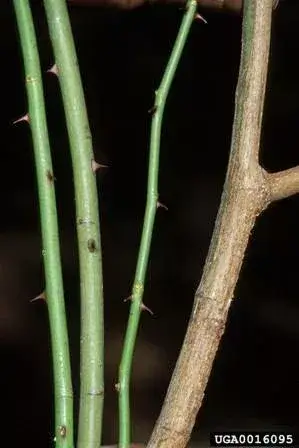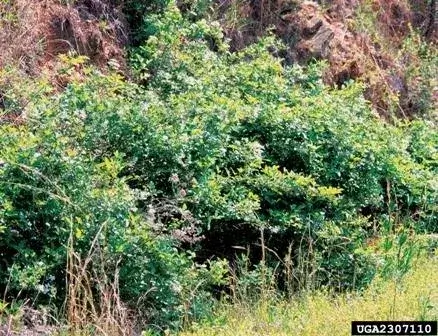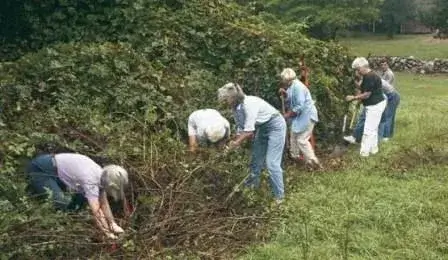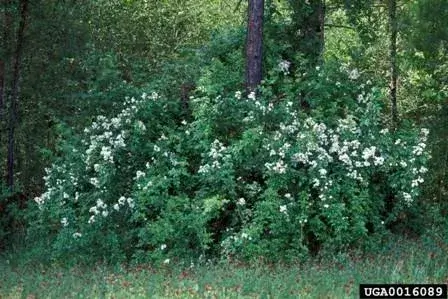
Multiflora rose, Rosa multiflora, also known as rambler rose and baby rose, is native to eastern China, Japan, and Korea. It was introduced to the U.S. from Japan in 1866 as rootstock for grafted ornamental rose cultivars. The spread of multiflora rose increased in the 1930s, when it was introduced by the U.S. Soil Conservation Service for use in erosion control and as living fences, or natural hedges, to confine livestock. It was also discovered to provide effective habitat and cover protection for pheasant, northern bobwhite, and cottontail rabbit and food for animals such as songbirds and deer. These uses encouraged its distribution, usually via root cuttings, to landowners through State Conservation departments. Mulitflora rose has recently been planted in highway median strips to provide crash barriers and reduce headlight glare from oncoming traffic. Its extensive, pervasive growth was soon discovered as a problem on pasture lands and fallow fields. Currently, mulitflora rose is found in 41 states and is classified as either a noxious weed, prohibited invasive species or banned, in 13 states, including Connecticut, Massachusetts, New Hampshire, New Jersey, and Pennsylvania. It is also ranked among the top forest invasive plant species for the northeastern area by the US Forest Service.
Multiflora rose, in the rose family (Rosaceae), is a vigorous perennial shrub. Canes (stems) root at the tips and may reach heights of up to 10 feet. The red-to-green twigs may have numerous recurved thorns; other thornless specimens occur infrequently in the eastern United States. Its pinnately compound leaves grow alternately with 5, 7, 9, or 11 oval, saw-toothed leaflets. The leaflets are nearly smooth on the upper surface and paler with short hairs on the underside. The base of each leaf stalk bears a pair of fringed bracts or stipules. The fringed stipules are the best characteristic to use to distinguish multiflora rose from other species. Multifora rose shrubs can grow to a height of 10-15 feet and to a width of 9-13 feet.

Clusters of showy, fragrant, white to white-pink, half-inch to one-inch diameter flowers, bloom in panicles, inflorescences with side stems, in late May or June. The flowers produce copious quantities of sweet pollen. Six to 100 hips develop in the inflorescence in summer and turn red by middle September, containing one to 21 seeds. The hypanthium, the large, fleshy cup-like structure on the underside of the flower, softens after early frosts, becoming tough, remaining on the plant in winter. Seed color is variable yellow to tan. The seeds themselves measure about 0.16 inches and are contained in sharp, thin-pointed structures called spicules. Seed germination is high; seeds can also remain viable in the soil for as long as 20 years. Roots are wide-ranging and capable of resprouting. In addition, stem tips that contact the soil surface are capable of rooting, through a process known as layering, to form new plants. Extensive thickets are formed this way.


Multiflora rose is extremely prolific and can form dense thickets, excluding native plant species. This non-native invasive rose invades open woodlands, forest edges, early succession pastures and fields. It also invades fence rows, right-of-ways, roadsides, and margins of swamps and marshes.


Each cane on a large plant may contain 40 to 50 panicles. Each panicle can contain as many as 100 hypanthia or hips (average of about 50) and each hip, an average of seven seeds (range of one to 22). Thus each large cane can potentially produce up to 17,500 seeds. Seeds remain viable for a number of years. It has been found that as many as 90% of the seeds are viable, in the absence of drought and stress. Multiflora rose is moderately winter-hardy, and is tolerant to many North American insects and diseases.

Multiflora rose thrives in full and partial sun with well-drained soils. It cannot tolerate winter temperatures below -28 F. While it grows most vigorously in full sun, it can also grow in the shade, and will persist for many years under a tree canopy although it may not flower or fruit very heavily.

Note: Mechanical and chemical methods are currently the most widely used methods for managing infestations of multiflora rose.
Mechanical: Seedlings can be pulled by hand. Small plants can be dug out or larger ones can be pulled using a chain or cable and a tractor, but care needs to be taken to remove all roots. Frequent, repeated cutting or mowing at the rate of three to six times per growing season, for two to four years, has been shown to be effective in achieving high mortality of mulitflora rose. In valuable, natural communities, cutting of individual plants is preferred to site mowing to minimize habitat disturbance. Some success has resulted from the use of goats in controlling multiflora rose.

Chemical: Herbicides have been used successfully in controlling mulitflora rose, but because of long-lived stores of seed in the soil, follow-up treatments are likely to be necessary. Applications of systemic herbicides, such as glyphosate or triclopyr, to freshly cut stomp or to re growth, may be the most effective method, especially if conducted late in the growing season. The same chemicals can be employed as a foliar spray. It is important to note that multiflora rose has the typical regenerative power of members of the rose family, and control programs must be monitored and followed up if necessary by repeated herbicide application or used in conjunction with other control methods such as mowing or burning. Plant growth regulators have been used to control the spread of mulitflora rose by preventing fruit set.
Biological: Rose rosette disease is a sometimes fatal viral disease that attacks multifora rose and other roses. The virus is spread naturally by a tiny mite. Plants affected by rose rosette disease develop witches’ brooms and small reddish leaves and shoots. The disease can kill plants in two years. This disease is not considered a useful biological control at this time because it may infect native roses and plums, as well as commercially important plants in the rose family such as apples, some types of berries, and ornamental roses.
Another biological control method involves the use of European rose chalcid (Megastigmus aculeatus), a wasp. During May and June the female deposits her eggs in the seed and the larvae overwinter. Pupa formation occurs in April to June and the adult wasps appear from the rose hip in early summer, thus completing the cycle. More research needs to be completed before considering this method of control.
This map shows confirmed observations (green points) submitted to the NYS Invasive Species Database. Absence of data does not necessarily mean absence of the species at that site, but that it has not been reported there. For more information, please visit iMapInvasives.
Rhoads, Ann Fowler and Timothy A. Block. 2000. The Plants of Pennsylvania: An Illustrated Manual. University ofPennsylvania Press, Philadelphia, PA.
Rhoads, Ann Fowler and William McKinley Klein. 1993. The Vascular Flora of Pennsylvania: Annotated Checklistand Atlas. American Philosophical Society, Philadelphia, PA.
USDA, NRCS. 2009. The PLANTS Database (http://plants.usda.gov). National Plant Data Center, Baton Rouge, LA 70874-4490 USA.
http://wiki.bugwood.org/Archive:BCIPEUS/Rosa_multiflora
https://elibrary.dcnr.pa.gov/GetDocument?docId=1738705&DocName=MultifloraRose.pdf
